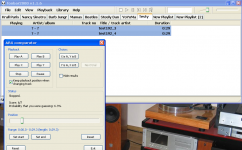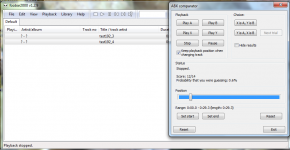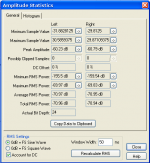Then why is one 5MB and the other 7? 😛
Oops my mistake, did not update dropbox folder.
New files to download
https://www.dropbox.com/s/u4ixox7fug9issj/test192_4.wav
https://www.dropbox.com/s/ob3yz0pod2i23e7/test192_3.wav
I am very sorry.
One of the files is redbook.
And you, as you claimed a better performance for 24 bit, need to participate to.
I have repaired my mistake, both coded in 24bits now.
Here is my ABX result:
Attachments
So I downloaded this foobar do-dah, then find it needs a plug in for ABX, then have a play to see how it works 😛
Once you know what are listening for its, well I won't say easy, put its do-able.
Edit... as you will see. I used a very narrow time window to play back to focus on differences.
Once you know what are listening for its, well I won't say easy, put its do-able.
Edit... as you will see. I used a very narrow time window to play back to focus on differences.
Attachments
Shaped dither when converting to 44.1kHz is poor choice. Common engineering mistake. Great for recording high sample rate.
Gaussian or triangular dither when doing SRC to 44.1kHz is better.
Crappy Audacity shaping in prior posts is perfect example.
Gaussian or triangular dither when doing SRC to 44.1kHz is better.
Crappy Audacity shaping in prior posts is perfect example.
Great result, Mooly!
heb1001, do you think that 2/2, that means 2 trials, is enough? 😛
No, you and Mooly ABX result. Good enough for me.
Shaped dither when converting to 44.1kHz is poor choice. Common engineering mistake. Great for recording high sample rate.
At least we may verify its ABX audibility 😉.
Can you explain why you think this?Shaped dither when converting to 44.1kHz is poor choice. Common engineering mistake. Great for recording high sample rate.
Gaussian or triangular dither when doing SRC to 44.1kHz is better.
Crappy Audacity shaping in prior posts is perfect example.
Whose shaped dither have you used?
With high sample rate and bit depth TPF dither may be applied repeatedly; slowly but surely raising noise floor in white noise. On final rendering all may be redistributed, typically packing more noise into HF or ultra-sonic range. Brick wall is used once on way to 44.1/48kHz.
Working within 44.1/48kHz sample rate, redistributing noise power leads to test192_3 and test192_4 possibilities. Sure, noise floor in sensitive region is lowered; but at what cost? When music signal drops down to make use of this apparent space, fine spatial character is lost, and is accompanied by HF hiss. I'd rather have smooth sinking of signal into noise with more thermal type of roll off.
Working within 44.1/48kHz sample rate, redistributing noise power leads to test192_3 and test192_4 possibilities. Sure, noise floor in sensitive region is lowered; but at what cost? When music signal drops down to make use of this apparent space, fine spatial character is lost, and is accompanied by HF hiss. I'd rather have smooth sinking of signal into noise with more thermal type of roll off.
Have you tried this?With high sample rate and bit depth TPF dither may be applied repeatedly; slowly but surely raising noise floor in white noise. On final rendering all may be redistributed, typically packing more noise into HF or ultra-sonic range. Brick wall is used once on way to 44.1/48kHz.
Working within 44.1/48kHz sample rate, redistributing noise power leads to test192_3 and test192_4 possibilities. Sure, noise floor in sensitive region is lowered; but at what cost? When music signal drops down to make use of this apparent space, fine spatial character is lost, and is accompanied by HF hiss. I'd rather have smooth sinking of signal into noise with more thermal type of roll off.
What are test192_3 and test192_4 ?
Pavel, this test is a lot easier than the cello one.
Do you think ? I didn't have the ABX thing for that one.
There is no way I could have differentiated these latest ones without being able to immediately compare one agains' 'tother. With the Bach I just listened normally... and preferred the degraded file 😀
--------------------------------------------------------------------------------------
Just to go off at a tangent for a moment...
The audible difference in the last two files to me was very small indeed, the Bach perhaps a little more obvious, but the really really vital thing is what the whole experience conveys. The Bach was wonderful whether as MP3 or the original, it was full of life and vibrancy whereas the Linn recording for all its technical credentials comes across as acoustically dry and dead and lacking any emotion. That is the kind of thing I was hoping some of these tests might hint at with differing equipment and devices such as the opamps in that our circuitry can "enhance" the experience in some way even if its at the expense of getting that last 0.000xxx something. That you listen with an open mind and pick what sounds best to you.
I'm losing the plot with this particular post of mine 😀 so I'll leave it there. Hope it makes some sense.
---------------------------------------------------------------------------------
Do you think ? I didn't have the ABX thing for that one.
Interesting. I struggled a lot on that one. The clarinet piece does sound dry, probably due to the type of the harmonics produced - mainly H3 and H5 from the instrument. The cello is one of my favorite instruments and sounds amazing no matter what quality recording is used! Always full, rich and is a good test of authority of speakers in their power range (100Hz - 500Hz).
It is crazy. This is the statistics of the difference file between test192_3 and test192_4 😀 .... and spectrum of the difference file
Attachments
Last edited:
- Status
- Not open for further replies.
- Home
- General Interest
- Everything Else
- Based on sonics... which do you prefer ?




